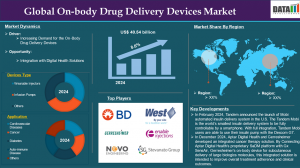On Body Drug Delivery Devices Market to Hit $82.74B By 2033 | CAGR 8.6%
The Global On Body Drug Delivery Devices Market is projected to grow from $40.54B in 2024 to $82.74B by 2033, expanding at a CAGR of 8.6% during 2025-2033.
Market Overview
The on-body drug delivery devices market has emerged as a transformative sector within the broader medical devices industry. These wearable systems are designed to deliver drugs over an extended period, offering convenience, improved patient compliance, and precise dosage control. Especially relevant for chronic disease management such as diabetes, cancer, and autoimmune disorders these devices are revolutionizing the way patients receive treatment outside traditional clinical settings.
Market Value and Growth
By 2025, the Global Market for on-body Drug Delivery Devices Market Size is witnessing robust growth and gaining significant traction. Valued at US$ 40.54 Billion in 2024, the market is projected to grow US$ 82.74 Billion By 2033 at a CAGR of around 8.6% over the forecast period.
A rise in chronic diseases requiring long-term drug therapy
Increasing demand for home-based treatment solutions
Advances in biologic drugs that require precise dosing
Patient-centric approaches to healthcare delivery
Wearable injectors, insulin pumps, and subcutaneous drug delivery patches are at the forefront of this surge, offering more freedom and control to patients. This shift from hospital-based infusions to self-administered, wearable solutions is also helping to reduce healthcare costs.
Regional Outlook
North America
North America remains a dominant force in the on-body drug delivery market, driven by the United States' strong healthcare infrastructure, high healthcare expenditure, and favorable reimbursement policies. The increasing prevalence of diabetes and cancer in the region fuels demand, along with rapid adoption of innovative drug delivery systems.
Europe
European countries like Germany, the UK, and France are witnessing increased uptake of on-body drug delivery devices, supported by growing awareness about self-care and a rising elderly population. Governments in the region are also investing in homecare support programs, creating a positive landscape for market players.
Asia-Pacific
The Asia-Pacific region is expanding at the quickest pace, driven by heightened healthcare awareness, a rising middle-class demographic, and a growing prevalence of chronic illnesses. Nations such as China, India, and Japan are at the forefront, embracing advanced technologies and implementing government-supported healthcare programs.
Key Companies
Prominent players in the market are focusing on innovation, strategic collaborations, and regional expansion to strengthen their position. Some of the major companies include:
BD
Gerresheimer AG
NOVO Engineering
West Pharmaceutical Services, Inc.
Enable Injections
Stevanato Group
LTS Lohmann Therapie-Systeme AG
Coherus BioSciences, Inc.
Tandem Diabetes Care, Inc
Battelle
Market Segmentation:
By Devices Type: Wearable Injectors, Infusion Pumps, Others
By Molecule Type: Small Molecule, Large Molecule
By Application: Cardiovascular Diseases, Cancer, Diabetes, Auto-immune Disease, Others
By Distribution Channels: Hospital Pharmacies, Retail Pharmacies, Online Pharmacies
By Region: North America, Latin America, Europe, Asia Pacific, Middle East, and Africa
Latest Developments
Innovations in material science, miniaturization, and Bluetooth-enabled monitoring features are defining the next generation of on-body drug delivery devices. Companies are also working on AI-integrated systems that can track adherence and provide alerts to healthcare providers in real time.
Moreover, regulatory authorities across the globe are streamlining approval pathways for wearable medical technologies, which is helping reduce the time to market for new devices.
Latest News of USA
In early 2025, several notable developments took place in the U.S. market. Amgen announced the next-generation Neulasta Onpro 2.0, designed with enhanced connectivity features and a more compact design. This iteration aims to further increase adherence among cancer patients undergoing chemotherapy.
Meanwhile, the FDA fast-tracked the approval of a novel wearable insulin patch developed by a Silicon Valley startup, which enables Bluetooth-enabled glucose monitoring and automatic dose adjustments through an app.
Healthcare providers are also showing strong interest in integrating wearable injectors into digital health platforms. For instance, a major hospital network in New York launched a remote patient monitoring program using on-body delivery systems for rheumatoid arthritis, improving patient satisfaction and treatment outcomes.
Latest News of Japan
Japan is witnessing significant momentum in this space, driven by its aging population and tech-savvy medical ecosystem. In early 2025, a Tokyo-based biotech firm released a compact on-body device for subcutaneous delivery of biosimilars used in cancer therapy, approved under Japan’s accelerated health technology route.
Additionally, Takeda Pharmaceuticals partnered with a local wearable tech company to develop smart injectors with cloud-based patient tracking. This initiative is part of Japan’s broader push to digitize healthcare and reduce the strain on hospitals.
The Japanese government is also investing in homecare medical devices through subsidies and innovation grants, signaling a long-term commitment to wearable therapeutic solutions. This is particularly relevant in rural regions, where access to frequent hospital care can be challenging.
Conclusion
With a strong push toward personalized healthcare, increasing prevalence of chronic diseases, and a global shift to home-based treatment, wearable drug delivery systems are well-positioned to become the standard of care.
Regional markets like North America and Asia-Pacific are driving innovation and adoption, while companies continue to push boundaries through R&D, partnerships, and technology integration. The latest advancements from the U.S. and Japan only reinforce the global momentum behind these life-enhancing medical devices.
Stay informed with the latest industry insights—start your subscription now: https://www.datamintelligence.com/reports-subscription
Most Recent Related Searched Reports By DataM Intelligence
Novel Drug Delivery System Market Size By 2031
Implantable Drug Delivery Devices Market Size By 2031
Sai Kiran
DataM Intelligence 4Market Research
+1 877-441-4866
Sai.k@datamintelligence.com
Visit us on social media:
LinkedIn
X
Legal Disclaimer:
EIN Presswire provides this news content "as is" without warranty of any kind. We do not accept any responsibility or liability for the accuracy, content, images, videos, licenses, completeness, legality, or reliability of the information contained in this article. If you have any complaints or copyright issues related to this article, kindly contact the author above.
Micro Drone Market Growth Insights and Statistical Analysis to show Expanding Industry Size
Morepen Laboratories Limited Expands to UAE: Step-Down Subsidiary in Dubai Mainland Support from Start Any Business
Upcycled Micro-Machines Go Global: Mecrob® Debuts as W.A.Y Studio’s New Art Brand
Więcej ważnych informacji
 Jedynka Newserii
Jedynka Newserii

 Jedynka Newserii
Jedynka Newserii

Polityka

D. Joński: Nie wiemy, co zrobi Rosja za dwa–trzy lata. Według duńskiego wywiadu może zaatakować kraje nadbałtyckie i musimy być na to gotowi
Zdecydowana większość krajów unijnych wskazuje na potrzebę wzmocnienia zdolności obronnych Europy w obliczu coraz bardziej złożonego geopolitycznego tła. Wywiady zachodnich państw wskazują, że Rosja może rozpocząć konfrontację z NATO jeszcze przed 2030 rokiem. Biała księga w sprawie obronności europejskiej „Gotowość 2030” zakłada m.in. ochronę granic lądowych, powietrznych i morskich UE, a sztandarowym projektem ma być Tarcza Wschód. – W budzeniu Europy duże zasługi ma polska prezydencja – ocenia europoseł Dariusz Joński.
Transport
Duże magazyny energii przyspieszą rozwój transportu niskoemisyjnego w Europie. Przyszłością może być wodór służący jako paliwo i nośnik energii

Zmiany w europejskim transporcie przyspieszają. Trendem jest elektromobilność, zwłaszcza w ramach logistyki „ostatniej mili”. Jednocześnie jednak udział samochodów w pełni elektrycznych w polskich firmach spadł z 18 do 12 proc., co wpisuje się w szerszy europejski trend spowolnienia elektromobilności. Główne bariery to ograniczona liczba publicznych stacji ładowania, wysoka cena pojazdów i brak dostępu do odpowiedniej infrastruktury. – Potrzebne są odpowiednio duże magazyny taniej energii. Przyszłością przede wszystkim jest wodór – ocenia Andrzej Gemra z Renault Group.
Infrastruktura
W Polsce w obiektach zabytkowych wciąż brakuje nowoczesnych rozwiązań przeciwpożarowych. Potrzebna jest większa elastyczność w stosowaniu przepisów

Pogodzenie interesów konserwatorów, projektantów, inwestorów, rzeczoznawców i służby ochrony pożarowej stanowi jedno z największych wyzwań w zakresie ochrony przeciwpożarowej obiektów konserwatorskich. Pożary zabytków takich jak m.in. katedra Notre-Dame w Paryżu przyczyniają się do wprowadzania nowatorskich rozwiązań technicznych w zakresie ochrony przeciwpożarowej. W Polsce obowiązuje już konieczność instalacji systemów detekcji. Inwestorzy często jednak rezygnują z realizacji projektów dotyczących obiektów zabytkowych z uwagi na zmieniające się i coraz bardziej restrykcyjne przepisy czy też względy ekonomiczne.
Partner serwisu
Szkolenia

Akademia Newserii
Akademia Newserii to projekt, w ramach którego najlepsi polscy dziennikarze biznesowi, giełdowi oraz lifestylowi, a także szkoleniowcy z wieloletnim doświadczeniem dzielą się swoją wiedzą nt. pracy z mediami.




![Nestlé w Polsce podsumowuje wpływ na krajową gospodarkę. Firma wygenerowała 0,6 proc. polskiego PKB [DEPESZA]](https://www.newseria.pl/files/1097841585/fabryka-nesquik_1,w_85,r_png,_small.png)




.gif)

 |
| |
| |
|